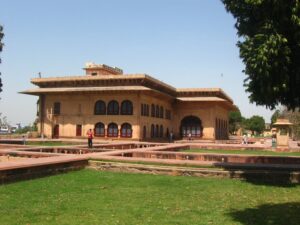
Deeg, strategically located between Delhi and Agra, was the capital of the Jat rulers in the early 18th century before they shifted to Bharatpur.

Commenced in 1725, the gardens at the Deeg Palace where the greatest artistic accomplishment of the Hindu King, Surajmal, the son of Jat ruler, Badan Singh, who founded the Jat house of Bharatpur. While the palace in part is characterized by a series of monuments within it, what distinguishes it is the garden that has been laid out with both rigour and exactitude.

The design of the gardens has been inspired by the Mughal Charbagh. The palace forms a quadrangle with a garden and walkways at its centre. Decorative flowerbeds, shrubs, trees and fountains cool the place considerably during summer. Two huge water tanks, Gopal Sagar and Rup Sagar, on either side also helped to bring down the temperature.

The palace is famous for the water system. Each plot is divided into four equal sized parterres by means of water channel with fountains. These parts were further divided into walkways in the middle. The palace houses over 900 fountains which is supplied by an overhead tank and water is supplied through earthen pipes (clay pipes).
The building of the gardens begin from 1725 and continued till the 18 the century. The Deeg Gardens is the best Mughal garden ever built after Pinjore. The pleasure palaces are set around formal Mughal gardens and are considered by some to be second only to the Taj Mahal in their beauty and symmetry.
Source
http://asi.nic.in/asi_monu_tktd_raj_deeg.asp
https://curatorhall.wordpress.com/2016/02/11/deeg-palace/
http://www.indiawaterportal.org/articles/palace-named-monsoon-rajasthan
http://www.panoramio.com/photo/111220945
http://www.indiamike.com/india/car-motorbike-and-bike-photologues-f166/bharatpur-trip-t148641/
https://www.flickr.com/photos/gaurhav/5322609952
http://www.unexploredweekendgetaways.com/2012_02_01_archive.html
https://www.panoramio.com/user/239454?with_photo_id=110245531


